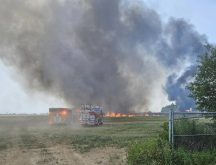Warm, damp conditions in 2024 have made for greater fusarium head blight risk in Ontario’s wheat crop.
In this video Albert Tenuta, OMAFA Provincial Field Crop Pathologist and Joanna Follings, OMAFA’s Provincial Cereals Specialist go through the risk this year, how to scout for and assess fusarium head blight in fields and how to manage it if it shows up. They were at the South Western Ontario Diagnostic Days in Ridgetown and are in one of the provincial cereals yield trial plots.
Read Also

Claas brings 1000 Series SP forage harvesters to Canada
In mid-August, Claas unveiled its new line of Jaguar forage harvesters at an event in Visalia, California, deep in the heart of that state’s dairy region.
What it matters: Fusarium head blight in wheat results in wheat that can’t be used for human consumption and is causes health problems in some livestock, so there’s a significant loss for farmers who have infected wheat to sell.
Here are some of their recommendations:
- Scout for fusarium regularly. Infection usually happens around time of flowering, but it can show up later in the crop.
- Assess fusarium head blight infection level by giving it a fusarium head blight index score:
- Grab 10 random wheat plants and assess which ones have fusarium infection, which gives incidence.
- If it’s one head out of 10, that’s 10 per cent incidence.
- Count the number of spikelets with infection per head to get the severity. If there are five out of 20 spikelets with infection, that’s a 25 per cent rate.
- Multiply the incidence by the severity, and then divide by 100, which in this case results in a fusarium head blight index of 2.5.
- A fusarium head blight index of more than three means that field should be harvested as soon as possible.
- Harvest infected fields first and consider drying the wheat if the index is above 10 and it means the crop can be salvaged for higher value markets.
- Lodged fields are at greater risk of fusarium infection so harvest them when possible.
- Increase fan speed at harvest to blow lighter kernels out the back, although getting this setting right is more challenging with newer combines which retain more kernels.












